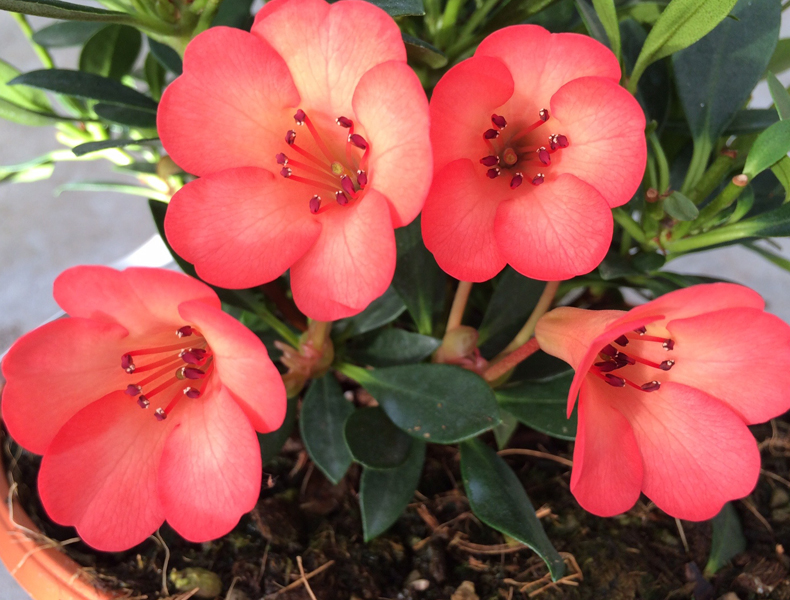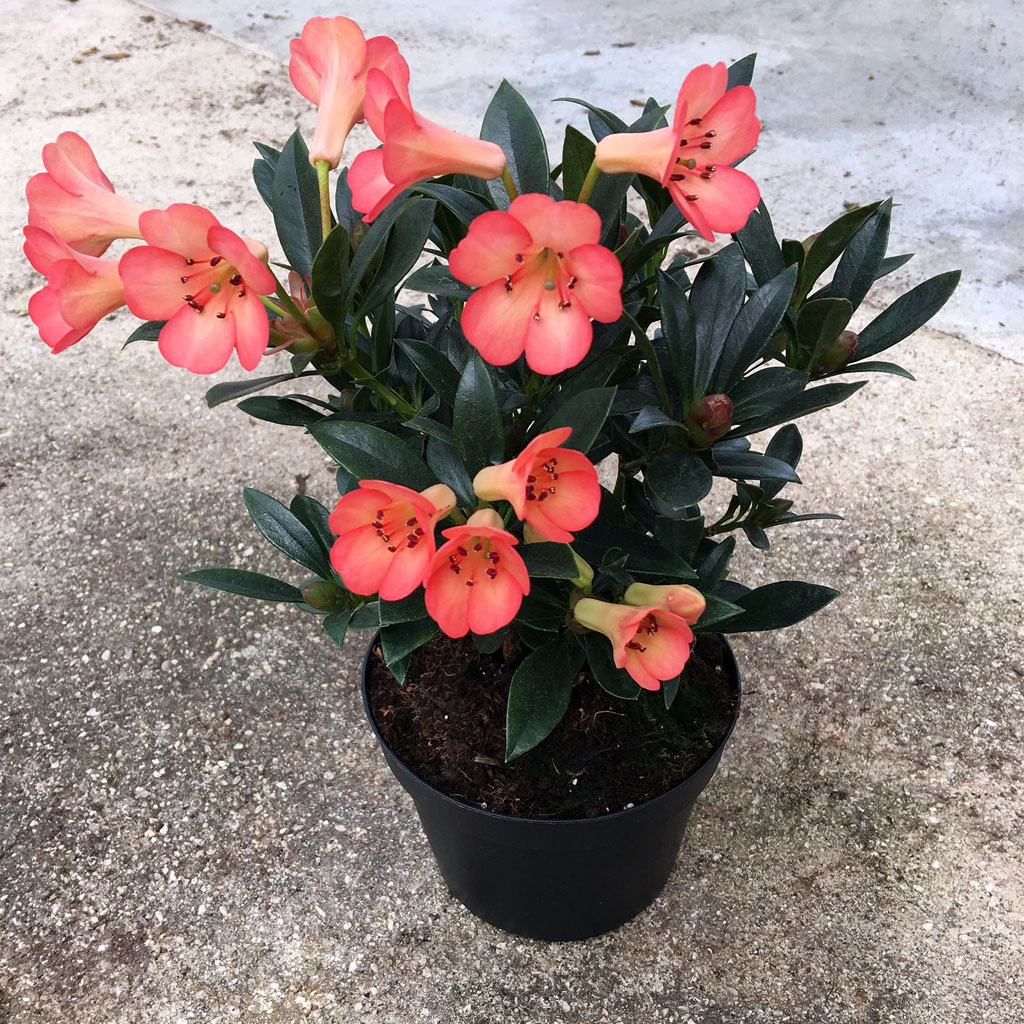Nursery Ciarrocchi Vireyas

Numbering over 300 species, Vireyas can be found growing across much of S.E. Asia, principally in New Guinea, Borneo, Sulawesi, Sumatra and the Philippines. Although these are tropical regions, vireyas mostly grow in the cool mountainous areas, either as epiphytes high in the tall trees of the cloud forest, or in more open ground in shrubberies. Here the climate is more temperate and this makes the vireya ideal for wider cultivation across many parts of the world.
Vireyas will reward you with regular displays of exotic, often scented, blooms in a range of vibrant colours, many backed by distinctive foliage with an attractive scaly covering.

The beautiful Vireya blooms in a range of vibrant colours in pot
Vireya Rhododendrons, like any other plants, have specific cultural requirements if they are to flourish and give pleasure to the grower. Fortunately, their demands are relatively modest and providing these basic needs are met they will provide enjoyment for many years.
Vireyas are distinguished from other rhododendrons in their taxonomy by a number of factors. Geographically they are centered on southeast Asia – including the Malay Archipelago, Indonesia, New Guinea, Borneo and the Philippines – a region where few other types of rhododendron are found.
The botanical characteristics used to separate the vireya group include the distinctive scales on their leaves; the presence of large idioblast cells within their leaves; distinct ovary, ovule and mega-gametophyte characters and their long tailed seeds. Also, it should be noted that vireya flowers contain no blue pigment and are never spotted.
The name “vireya” was first used by Carl Blume, director of what is now the Bogor Botanic Garden, Indonesia, in 1826. Blume was describing five new species of rhododendron (only two other species were known from the region at that time) and he proposed a new genus Vireya to accommodate them – this to honour his friend Julian Joseph Virey, a French pharmacist and natural historian. While the rank of genus was rejected by Blume’s peers, the name Vireya continued to be used for that Section (now Subgenus) of the genus Rhododendron

Many vireya species grow as epiphytes in their natural environment, high in the trees of the cloud forest, and so have adapted to surviving with only a small covering of moss or humus over their roots, which makes them ideal subjects for pot culture. The smaller vireyas will grow happily in a pot for many years and even larger plants have only relatively modest root systems – vireyas do not have tap roots, instead forming a mat of fine roots near the surface, and so can be easily re-potted as they outgrow their containers.
Growing vireyas in pots also has the advantage of being able to move them under shelter during cold spells and to even bring them into the house to enjoy when in bloom.
TIPS FOR GROWING VIREYAS
- DO NOT OVER-WATER
- DO NOT OVER-FERTILIZE
- DO NOT OVER-POT
- DON’T KEEP YOUR PLANT DRY – JUST LET IT BECOME LIGHTWEIGHT AND THEN WATER THOROUGHLY.
Vireya Rhododendrons grow in the wild areas of New Guinea, Borneo and throughout the Malay-Indonesian chain of islands. You can enjoy their brilliant colors year round with the use of solariums, attached greenhouse rooms, terrace&patio, hobby greenhouses, or outside in frost-free climates.
We have found that these exotic plants are very easy to grow as long as they are not exposed to below-freezing temperatures. If other houseplants thrive for you, the Vireyas will do equally well.
Dry house air is definitely not desirable. You can modify dry air by using a humidifier, or by placing bowls of water near the plants.
Where to grow
• Outside all year in frost-free areas.
• Outside after the last spring frost and until the first frost.
• Bring into a greenhouse, atrium, enclosed sunroom, etc., before the first frost.
• If only a rare, mild frost, provide temporary protection by covering your plants.
• In a living area, with added humidity, and light.
• In a greenhouse year round.
• Morning sun is desirable with filtered sun and shade in the afternoon.
Growing medium and potting practices
A soil-free, acidic mix is used to simulate the native conditions where these plants are often found on high, moss-covered boughs of trees. To achieve a loose, well-aerated mix with quick drainage but with water retention abilities, we recommend the following: two parts coarse peat, one part perlite (orchid bark work salso well if available).
Pot size
The plants we ship to you are usually either two or three years old. We suggest keeping your plants in the containers in which received for at least one year. Vireyas like the drainage provided by a taller pot and they like to be slightly pot bound. When you think it is time to repot, we advise not over-potting, that is, not putting it in a much larger pot. A plant received in a 15cm. pot (1,6 liters) should be moved to a 17cm. Pot (2,3 liters). A 19cm. pot should be moved to a 21cm. pot (4,6 liters). A restricted root area means that there is less medium to stay soggy after watering. The sides and bottom of the root ball should be loosened so that the roots will move out into the new potting mix.
Light conditions
When plants are outdoors, direct sun from sunrise to 11 or 12 and filtered sun thereafter is ideal. During the colder, darker winter months (Dec-Feb) plants experience a slow-down in growth, although not a true period of dormancy. Vireyas come from a 12-hour day area. They can get along without supplemental light, but would love some if they are not outside or in a greenhouse.
Temperatures
Vireyas will usually not survive freezing temperatures. Some plants might even get through a light frost but you should not take the chance. Temporarily cover plants outside or move them inside somewhere. We keep our vireyas in our greenhouses that are heated when the interior temperatures drop to 2ºC. Based on their natural growing conditions, we recommend that it is best to provide a change between day and night temperatures rather than a constant warm temperature.
Pruning
You can encourage bushy plants by pruning and pinching young plants when they are only a few inches high and up to about two or three years old. At that point avoid pruning and pinching until after blooming. Even though flower buds may not be evident, a late pinch might prevent the plant from blooming the next season. Flower buds often wait for the second or third flush of growth. The plants ultimate size is naturally an important consideration. After a branch has bloomed you can prune it back as far as needed to maintain the shape. To prune large older plants establish a routine of pruning 1/3 of the plant each year, if you want. Don’t forget to deadhead and do not be afraid to prune.
Disease and Pests
The same practices apply to vireyas as to other rhododendrons.
• Powdery mildew can be a problem but is easily controlled with any mildew spray.
• If Rust infects other rhododendrons in your garden it may spread to your Vireyas. A general fungicide recommended for roses will normally take care of the problem. Good sanitation practices are always a smart move.
• Aphids and Scale occasionally appear but are easily controlled using available commercial products. Pay attention to Miteseven if it is a minor problem.
• Very rarely “die-back” (black stem, dropping leaves) may appear. This is different for the normal darkening of branches. Immediately prune back to healthy wood, dispose of the diseased parts (not in yard debris recycling or compost piles) and sterilize your pruning shears. Because these are semi-tropical plants, there is a constant renewal of foliage. However, if the newer leaves are dropping you may have a problem, usually caused by over-watering or over-fertilizing.
• Phytophtora (root rot) fungus is carried through the soil in water and can infect rhododendrons if drainage is poor or if pots are over-watered or sitting on contaminated ground. If you scratch the bark at the base of the trunk and you find brown, not green tissue it is Phytophtora. A plant dying from Phytophera can not be saved and should be discarded in the trash (plant and soil), not in yard debris for recycling or in the compost pile. Pots should be treated with Clorox if you want to reuse them.
FERTILIZING AND WATERING PRACTICES ARE THE TWO MOST IMPORTANT POINTS IN THE SUCCESSFUL CULTURE OF VIREYA RHODODENDRONS.
Feeding
There are two methods. Either fertilizing with a water soluble fertilizer such as Peters 20-20-20 at very low concentration at each watering or, using a slow release fertilizer with macro nutrients, iron chelate and trace elements. We recommend using a slow release fertilizer every three or four months. Water immediately after fertilizing to prevent surface caking. Do not allow the fertilizer to sit in a lump against the stem. A harmless gray mold will appear in the first two weeks but disappears after watering.
If you have foliage turning brown along the edges you may have used too much or too strong a fertilizer. Use lots of water to leach the fertilizer out of the soil. A white crusty buildup around the top inside of the pot also indicates too much fertilizer or insufficient leaching of fertilizer salts.
Watering Practices
Avoid a continually soggy potting mix. As a general rule, water thoroughly, and then withhold water until the pot feels light, before watering again. Always water from the top until it runs out the bottom. Do not let your plants sit in water. It is hard to resist the urge to water your plants. But you must learn to lift them and only water when they feel light.
DON’T KEEP YOUR PLANT DRY. JUST LET IT BECOME LIGHTWEIGHT AND THEN WATER THOROUGHLY
You must never listen to flowers. Just look at them and smell them
- Antoine de Saint-Exupéry

 English
English Italiano
Italiano  Deutsch
Deutsch  Français
Français 

